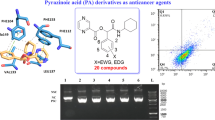Summary
Molecular topology (MT) was used to develop quantitative structure-activity relationship (QSAR) models to screen databases for new anticancer compounds. One of the selected compounds was MT103, an isoborneol derivative, with a promising profile predicted to slow tumor growth through pro-apoptotic signaling and protein kinase C inhibition. We found that MT103 inhibited the growth of a wide variety of cancer cell types as verified by the NCI-60 cancer cell line panel. MTT cell viability assay showed that MT103 inhibited 50% of the growth of HOP-92, ACHN, NCI-H226, MCF-7, and A549 cancer cell lines at much lower concentrations than that required for HUVECs and human fibroblasts. MT103 stimulated apoptosis in NCI-H226 lung carcinoma cells as measured by oligonucleosomal DNA fragmentation. However, protein kinase C was not targeted by MT103, as predicted by in silico modeling. MT103 slowed in vivo tumor growth and metastatic spread of NCI-H226 cells injected subcutaneously into NOD/SCID mice, without eliciting any severe adverse events as monitored by animal survival, blood serum analysis, and histological analysis of organs. Oral administration of MT103 nanoparticles (200 nm in diameter), which were generated with ElectroNanospray™ technology, inhibited in vivo growth of HOP-92 lung carcinoma cells almost as effectively as intraperitoneal injections of cisplatin. Taken together, our study of a novel anti-cancer drug identified using a molecular topology-based approach to drug discovery demonstrates that MT103 has anti-tumor activity in vitro and in vivo, although additional studies are needed to elucidate its mechanism of action.





Similar content being viewed by others
References
Galvez J, Garcia-Domenech R, de Julian-Ortiz JV, Soler R (1995) Topological approach to drug design. J Chem Inf Comput sci 35(2):272–84
Garcia-Domenech R, Galvez J, de Julian-Ortiz JV, Pogliani L (2008) Some new trends in chemical graph theory. Chem Rev 108(3):1127–69
Llompart J, Galvez J, Pal K (2006) Inventors; US Patent 20060014770
Jasinski P, Zwolak P, Terai K, Dudek AZ (2008) Novel Ras pathway inhibitor induces apoptosis and growth inhibition of K-ras-mutated cancer cells in vitro and in vivo. Transl Res 152(5):203–12
Jasinski P, Welsh B, Galvez J et al (2008) A novel quinoline, MT477: suppresses cell signaling through Ras molecular pathway, inhibits PKC activity, and demonstrates in vivo anti-tumor activity against human carcinoma cell lines. Invest New Drugs 26(3):223–32
Llompart J, Galvez J (2005) Inventors; US Patent 20056919376
Shoemaker RH (2006) The NCI60 human tumour cell line anticancer drug screen. Nat Rev 6(10):813–23
Stinson SF, Alley MC, Kopp WC et al (1992) Morphological and immunocytochemical characteristics of human tumor cell lines for use in a disease-oriented anticancer drug screen. Anticancer Res 12(4):1035–53
Dudek AZ, Bodempudi V, Welsh BW et al (2007) Systemic inhibition of tumour angiogenesis by endothelial cell-based gene therapy. Br J Cancer 97(4):513–22
D'Argenio D (1997) Adapt II user’s guide: Pharmacokinetic/pharmacodynamic system analysis software. Biomedical Simulations Resource, Los Angeles
Pui DYH, Chen D-R (2004) Inventor Electrospraying Apparatus and Method for Coating Particles patent US Patent#6,746,869. June 8, 2004
Pui DYH, Chen D-R (2000) inventor Electrospraying Apparatus and Method for Introducing Material into Cells patent US Patent# 6,093,557. July 25, 2000
Kaplan ELMP (1958) Nonparametric estimation from incomplete observations. J Am Stat Assoc 53:457–481
Dudek AZ, Zwolak P, Jasinski P, Terai Kaoru, Gallus NJ, Ericson ME, Farassati F (2007) Protein kinase C-β inhibitor enzastaurin (LY317615.HCI) enhances radiation control of murine breast cancer in an orthotopic model of bone metastasis. Invest New Drugs, August 6
Acknowledgements
A research grant from Medisyn Technologies partially supported the work described in the manuscript. We thank Michael J. Franklin, MS of the Division of Hematology, Oncology and Transplantation at the University of Minnesota for editing the manuscript.
We thank Dr Robert A. Hoerr from Nanocopeia, Inc., St. Paul, MN for help with the nanoformulation of MT103.
Author information
Authors and Affiliations
Corresponding author
Rights and permissions
About this article
Cite this article
Jasinski, P., Zwolak, P., Isaksson Vogel, R. et al. MT103 inhibits tumor growth with minimal toxicity in murine model of lung carcinoma via induction of apoptosis. Invest New Drugs 29, 846–852 (2011). https://doi.org/10.1007/s10637-010-9432-4
Received:
Accepted:
Published:
Issue Date:
DOI: https://doi.org/10.1007/s10637-010-9432-4




